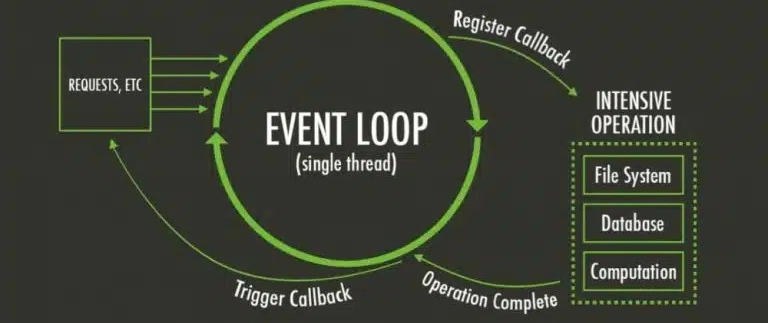Node.js is widely known for its non-blocking, asynchronous architecture, which allows it to handle a large number of concurrent operations efficiently. At the core of this architecture lies the Event Loop, a fundamental concept that enables Node.js to perform asynchronous tasks without multiple threads. Understanding the event loop is crucial for writing efficient and scalable Node.js applications.
What is the Event Loop?
The event loop is the mechanism that allows Node.js to perform non-blocking I/O operations by offloading tasks to the system kernel whenever possible. It continuously monitors and executes operations in a loop, ensuring that tasks are executed efficiently while maintaining the single-threaded nature of Node.js.
The event loop processes tasks asynchronously by utilizing callback functions, Promises, and async/await. This mechanism enables Node.js to handle multiple operations, such as file I/O, network requests, and database queries, without waiting for each task to complete before proceeding to the next one.
Event Loop Phases
The Node.js event loop consists of multiple phases, each responsible for executing specific types of tasks. These phases occur in a cyclical order:
1. Timers Phase
- Executes setTimeout() and setInterval() callbacks if their designated time has elapsed.
- Timers are not guaranteed to execute precisely at the scheduled time due to delays caused by other queued tasks.
2. I/O Callbacks Phase
- Handles callbacks from I/O operations, such as file system operations and network requests.
- These callbacks are executed once I/O operations complete.
3. Idle, Prepare Phase
- Internal phase used by Node.js, primarily for optimizations and internal processes.
- This phase is usually not directly relevant to application development.
4. Poll Phase
- The most crucial phase of the event loop.
- Handles new I/O events and executes callbacks for I/O-related tasks.
- If no I/O tasks are pending, the event loop may enter an idle state, waiting for new events.
5. Check Phase
- Executes callbacks scheduled via setImmediate().
- Callbacks in this phase run immediately after the poll phase is complete.
6. Close Callbacks Phase
- Executes callbacks for closed resources, such as socket.on('close', callback).
- Ensures that cleanup operations for closed connections are handled efficiently.
After completing all phases, the event loop starts over and continues processing pending tasks.
setTimeout vs. setImmediate
Many developers confuse setTimeout() and setImmediate(), but they operate differently in the event loop:
-
setTimeout(callback, 0): Places the callback in the Timers Phase and executes it after the specified delay (minimum of 1 millisecond if 0 is given). -
setImmediate(callback): Schedules the callback in the Check Phase, ensuring it runs after the poll phase completes.
Example:
setTimeout(() => console.log("Timeout Executed"), 0);
setImmediate(() => console.log("Immediate Executed"));
Output order depends on execution time, but typically, setImmediate() runs before setTimeout() with 0ms delay.
Understanding Process.nextTick()
process.nextTick() is a special function that executes callbacks before the next event loop iteration starts. This makes it higher priority than setTimeout or setImmediate.
Example:
console.log("Start");
process.nextTick(() => console.log("Next Tick"));
console.log("End");
Output:
Start
End
Next Tick
Unlike timers or immediate functions, process.nextTick() runs immediately after the current operation but before moving to the next phase of the event loop.
Practical Example of the Event Loop
Consider the following example demonstrating the execution order of different asynchronous operations:
console.log("1: Start");
setTimeout(() => console.log("2: Timeout"), 0);
setImmediate(() => console.log("3: Immediate"));
process.nextTick(() => console.log("4: Next Tick"));
console.log("5: End");
Expected Output:
1: Start
5: End
4: Next Tick
3: Immediate
2: Timeout
Explanation:
- Synchronous code runs first (
console.log("1: Start")andconsole.log("5: End")). -
process.nextTick()executes before moving to the event loop. -
setImmediate()executes in the Check Phase, which occurs before Timers Phase. -
setTimeout()executes in the Timers Phase, slightly later.
Conclusion
The event loop is the heart of Node.js, enabling it to handle asynchronous tasks efficiently. Understanding how it processes different tasks helps developers write optimized and high-performance applications. By mastering the event loop, you can make informed decisions about using timers, immediate functions, and nextTick, ultimately improving the efficiency of your Node.js applications.
Would you like a deeper dive into any specific aspect of the event loop? Let us know in the comments!



Top comments (0)